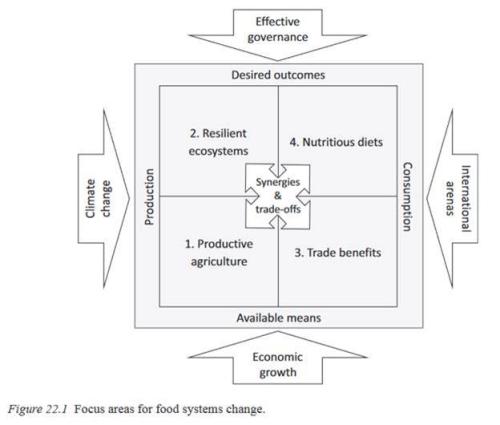This book examines Africa’s current food system and future challenges for food security over the next 25 years, amidst a rapidly growing population, climate change, and socio-economic transformations. It provides a comprehensive analysis of past, present, and future dynamics shaping African food systems.
The book begins with four contrasting case studies that focus on country-specific challenges in Egypt, Ethiopia, Senegal and Zimbabwe.
They were selected in their relation to agricultural intensification and structural change of the agricultural sector and illustrate the big diversity in countries. Egypt and Senegal have experienced growth of agricultural productivity growth as well as structural change (path of inclusive structural change), while Ethiopia shows growth in productivity but remain in the early phases of structural change (path of agricultural growth), and Zimbabwe has faced decades of stagnation and even regression in its agricultural sector (path of agricultural stagnation).
 |
 |
Further, it addresses key challenges in 15 thematic chapters, including demographic pressures, yield and nutrient gaps, malnutrition, global markets, water shortage, livestock and, farm sizes.
The concluding chapter of the book starts with the sentence “Achieving food and nutrition security in Africa by 2050 is one of the most challenging and important ‘wicked’ problems facing humanity”. While the population has also grown fast in the past (from 0.28 billion in 1960 to 1.46 billion in 2023) Africa will soon shift to become comparatively densely populated continent and be home to a quarter of the world’s population. In parallel to this demographic growth Africa’s food systems face many challenges.
African food system needs to transform at a much faster pace to ensure that the people it serves are food secure. The book concludes by discussing key pathways to improve Africa's food system and food security for the decades ahead, using a food system framework (see figure) that looks at 4 interrelated areas (agriculture, ecosystems, trade and nutrition), while taking into account: desired outcomes and the available means, the external forces such as economic growth, governance, climate change and international collaboration.

From this the authors derive four drivers that could set the transformation in motion:
- Change due to crises: Conditions need to deteriorate before new windows to improve food security open up.
- Institutional ripple effect: Countries get their policies right, which could include effective governance, trade protection of domestic producers, consumption policies and become trend setter on the continent.
- Regional or pan-African initiatives: Regional cooperation would reduce reliance on food imports from outside Africa and opportunities for specialization increase. Targeted policies
- Global responsibility: The North works closely together with African countries to drive desired change, i.a. with investments in infrastructure and institutions, firm policies for fair value additions and increased mobility towards countries facing labour shortage.
| Year of publication | |
| Authors | |
| Publisher | Taylor & Francis |
| Geographic coverage | AfricaEgyptEthiopiaSenegalZimbabwe |
| Originally published | 27 Jan 2025 |
| Knowledge service | Metadata | Global Food and Nutrition Security | Food security and food crisesClimate extremes and food security NutritionSustainable Food Systems | Food systems transformationFarm sizeAgricultural yield gapFood price crisisWater for food security and nutrition |
| Digital Europa Thesaurus (DET) | agricultural marketpopulation dynamicsclimate changewateragricultural policyagricultural trade |
